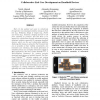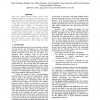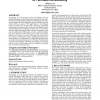41 search results - page 3 / 9 » Accessing the Web on Handheld Devices for Visually Impaired ... |
VL
2008
IEEE
13 years 11 months ago
2008
IEEE
Web 2.0 has enabled end users to collaborate through their own developed artifacts, moving on from text (e.g., Wikipedia, Blogs) to images (e.g., Flickr) and movies (e.g., YouTube...
ISWC
2006
IEEE
13 years 10 months ago
2006
IEEE
Blind and visually-impaired people cannot access essential information in the form of written text in our environment (e.g., on restaurant menus, street signs, door labels, produc...
AVI
2004
13 years 6 months ago
2004
Increasingly, rich and dynamic content and abundant links are making Web pages visually cluttered and widening the accessibility divide for the disabled and people with impairment...
CHI
2003
ACM
14 years 5 months ago
2003
ACM
People with motor impairments often cannot use a keyboard or a mouse. Our previous work showed that a handheld device, connected to a PC, could be effective for computer access fo...
CHI
2006
ACM
14 years 5 months ago
2006
ACM
Access to digitally stored numerical data is currently very limited for sight impaired people. Graphs and visualizations are often used to analyze relationships between numerical ...



